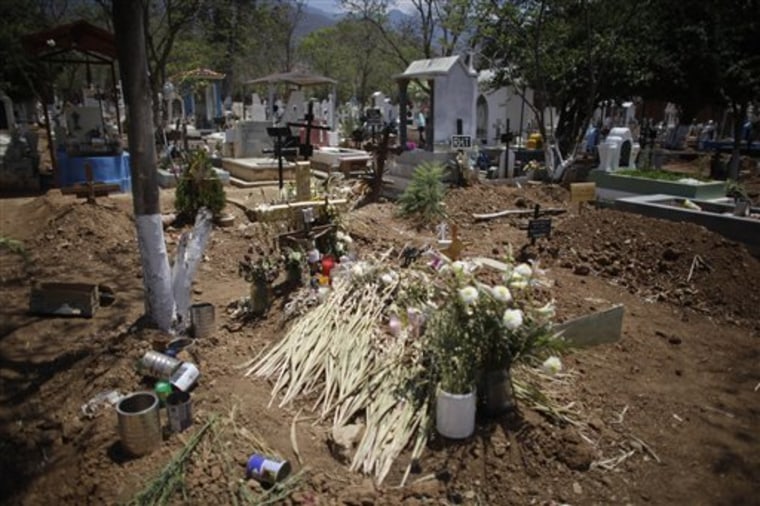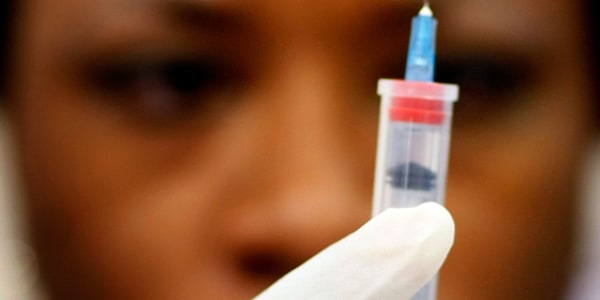Doctors couldn't figure out what was wrong with the first person to die of swine flu. The 39-year-old woman arrived at their hospital gasping for air, her hands and feet blue from oxygen-starved blood.
They administered antibiotics, but she only got worse. They hooked her to a ventilator. They sent a saliva sample to a local private lab. On April 12, her third day in the intensive care unit, the test results indicated it might be coronavirus — a highly contagious disease associated with severe acute respiratory syndrome, or SARS.
Dr. Jesus Salcedo, director of the Dr. Aurelio Valdivieso General Hospital, realized he had a potential crisis on his hands. The ward Adela Maria Gutierrez shared with at least 20 seriously ill patients had to be quarantined. His terrified staff demanded better protective gear or a transfer.
"The religious ones said, 'This is a punishment from God and we're all going to die,'" Salcedo recalled Wednesday in an exclusive interview with The Associated Press.
A day later, Gutierrez died — just before a second round of tests came back negative for coronavirus.
Desperate hunt
Hospital and health workers then began a desperate hunt to find the source of the mystery disease and who else may have been contaminated. It has since been identified as a mutated swine flu suspected in 168 deaths in Mexico that has spread to at least eight other countries, triggering an unprecedented global alert.
The case vividly shows why the virus has been so difficult to contain in Mexico.
The medical teams did some of the sleuthing that epidemiologists recommend for tracking a killer bug, interviewing 472 people who may have come into contact with Gutierrez, a mother of three who had been going door-to-door in a temporary job with Mexico's tax collection agency.
They took more samples from Gutierrez and sent them to Mexico's National Institute of Epidemiological Diagnosis and Reference, which forwarded them to a lab in Canada.
They closed the ICU to new patients until the exposed ones were well enough to leave, telling them they should return immediately if they had flu symptoms. None did, Salcedo said.
But the follow-up appears to have been weak — just like the initial response to swine flu outbreaks in other parts of Mexico, where victims' families have yet to be contacted by health workers to see if they also contracted the illness.
In the end, only 18 people — all hospital workers — were tested for swine flu after Gutierrez's sample came back positive around April 20, said Dr. Ruben Coronado, director of Oaxaca's department of epidemiology.
In her last days, Gutierrez had worked closely with another temporary employee, interviewing taxpayers and filling out forms to update the tax registry. That woman had a bad cough, her family said, and was from Veracruz, the state where Mexico's earliest case of swine flu was confirmed: 5-year-old Edgar Hernandez, who survived.
About 450 people had been diagnosed in the Veracruz town of La Gloria with acute respiratory infections, but only 35 were tested for the new virus. Edgar's was the only test that came back positive.
Too frightened to attend wake
Gutierrez lived in a two-story home where the family runs a convenience store. Her husband, a welder, declined to be interviewed.
"They're really afraid and they don't know what's going on," state Health Secretary Dr. Martin Vasquez said of the family.
Gutierrez was buried the day she died, odd in Mexico where a wake is customarily held overnight, with burial held the next day. Already rumors were circulating that she died of a very contagious disease.
Slideshow 21 photos
Swine flu worries world
Four houses away, Hermelinda Leon was too frightened to attend the wake. She, her husband and three children had all been ill with similar symptoms starting April 7. Leon had a fever of 104 degrees Fahrenheit and spent several days in bed before her doctor gave her antiobiotic injections. Antibiotics don't kill viruses, although they may work against related bacterial infections that sometimes occur.
"When they told me the neighbor died from a sore throat, I was worried because I was so sick from a sore throat, I felt like I was going to die," she said.
Hospital didn't have Tamiflu
The Leon family recovered without the help of Tamiflu or other antiviral medicines. Salcedo said his hospital didn't have any at the time, but has since stocked up and is treating 11 people with Tamiflu.
Three days later, health workers came to interview Leon, who caters food to Oaxaca hotels. They asked about the family's illness, symptoms, their medications and said they would return to give them a special test. She said they never did.
A day after Salcedo learned from the Canadian lab that Gutierrez had swine flu, two other patients died of pneumonia in the Oaxaca hospital. They weren't tested for swine flu because they didn't show atypical symptoms, Salcedo said. Gutierrez's family also never showed any symptoms, he said.
Coronado said only 18 of all the people interviewed were tested for swine flu because the others didn't show signs of the disease — even though Leon's family had similar symptoms. Coronado told AP he wasn't familiar with the Leon case.
Of the 18 saliva samples taken from medical staff, 12 did not have enough cells to be tested. The other six came back negative for swine flu, Coronado said.
Health officials say Ooxaca's 11 current cases of suspected swine flu are unrelated to the tax workers, but the lack of followup with the Leon family suggests they haven't tracked down every connection. Three victims remain hospitalized and eight went home after receiving anti-viral drugs. No other cases in Oaxaca have been confirmed.
Salcedo guessed that no one else in the Gutierrez and Hernandez families got sick because their immune systems were simply strong enough to withstand the swine flu virus. But Mexico's Health Secretary Jose Cordova said Thursday that this remains a mystery.
"We still don't know why it's more aggressive in some people and not in others," Cordova said.

